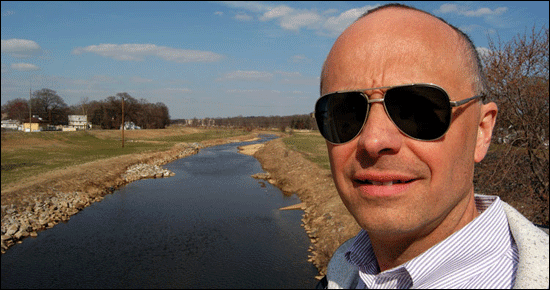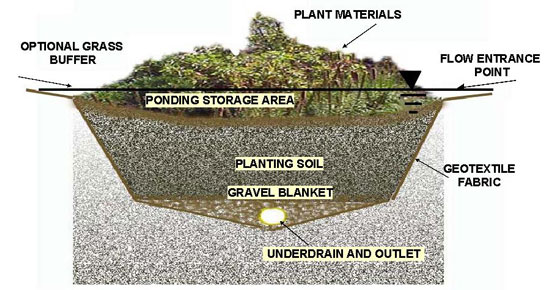![[Chesapeake Quarterly masthead]](/images/uploads/siteimages/imported/masthead.gif)
![[Chesapeake Quarterly masthead]](/images/uploads/siteimages/imported/masthead.gif) |
|
2006
|
Volume 4, Number 4
|
Table of Contents
|
Subscribe
|
Download pdf
|
|
Bend in the River: Engineering Takes a Turn
By Jack Greer Modern development continues to reshape much of the Chesapeake watershed. Bulldozers level once variable landscapes, and construction covers the earth with miles of asphalt and concrete. To move water from this hardened landscape, engineers design pipes and drains, gutters and culverts — stormwater systems that carry water away from our homes and highways. Now growing torrents of diverted stormwater have damaged local streams and creeks, and engineers are taking on another challenge — restoring the landscape's natural hydrology. In Prince George's County, Maryland, stormwater experts led by Larry Coffman began to experiment with new techniques aimed at reducing the flow of damaging stormwater in the Anacostia watershed. They called these methods low impact development or LID. Their approaches were blazing a new path in stormwater management, but what they didn't have was compelling scientific evidence that their techniques were working. In 1991, Coffman came to the University of Maryland looking for help. There he found a willing cooperator in engineering professor Allen Davis. Davis did not start out working on stormwater. When Coffman first appeared, Davis was focusing on aquatic chemistry, but was intrigued that there was "virtually no research" on the effectiveness of new stormwater techniques like bioretention. Davis took on the challenge, and now works at the forefront of civil engineering's new bent, the field of environmental engineering. Seated in his office in the Department of Civil and Environmental Engineering and surrounded by stacks of journal articles, papers, and reports, Davis says that stormwater is finally getting some of the attention it deserves. The stormwater symposium held in November 2005, the one attended by citizen activist Irene Hantman, drew the biggest turnout they've ever had for one of their meetings. He has become a firm believer in the art of nature-based treatments, which can take the form of grassy swales, rain gardens, or other terraced and vegetated areas. These devices work, Davis says. They can change the way runoff moves across the urbanized landscape, and prevent the kind of blowout of streams so common in developed areas. That means that they can help slow the rapid erosion that not only wrecks streams and their food webs, but that also sends tons of sediment downstream into rivers like the Anacostia and the Potomac. And into small tributaries like Beards Creek. By now Davis has worked not only with Prince Georges County but also with Montgomery County, Washington, D.C., and the Maryland State Highway Administration. He has not yet worked with Anne Arundel County, where Irene Hantman and her neighbors struggle to change old ways of thinking about stormwater before the damage is done. There are barriers, he says. These range from cost, to inexperienced administrators and contractors, to just plain inertia. (See "How to Slow the Flow") Fifteen years after he first took it on, stormwater has become his passion. "Ninety-five percent of my work is now stormwater and LID [low impact development]," he says. "In many ways it's overwhelming," he adds. "There's just so much to do." Davis points out that he's a faculty researcher, a teacher. He has his research lab to keep going and six graduate students to support, in addition to teaching classes in environmental engineering and water chemistry. He regularly fields phone calls and e-mails from across the country from those who want to know more about bioretention. "There is enough research in this area to keep me busy the rest of my career," he says. "It consumes my life." 

A rain garden, such as the one shown above, says Allen Davis (above top), is one of the methods that can lessen the effects of stormwater on the environment. It redirects runoff from impervious surfaces to green areas that keep water onsite. With its thin layer of mulch densely planted with grasses, shrubs, and small trees covering an underlayment of porous soil, it can be designed to mimic natural hydrologic processes to absorb and filter water through uptake by plants, evaporation, and soil filtering mechanisms.
|
|
|
Top of Page |
|
|
Home |
Contents |
Other Issues |
|
|
|
||||
![[Maryland Sea Grant]](/images/uploads/siteimages/imported/h_footer_mdsg.gif) ![[NOAA]](/images/uploads/siteimages/imported/h_footer_noaa.gif) |
This page was last modified April 12, 2006 |